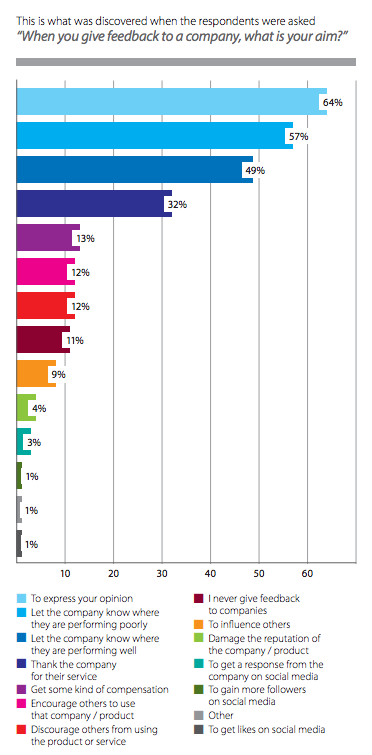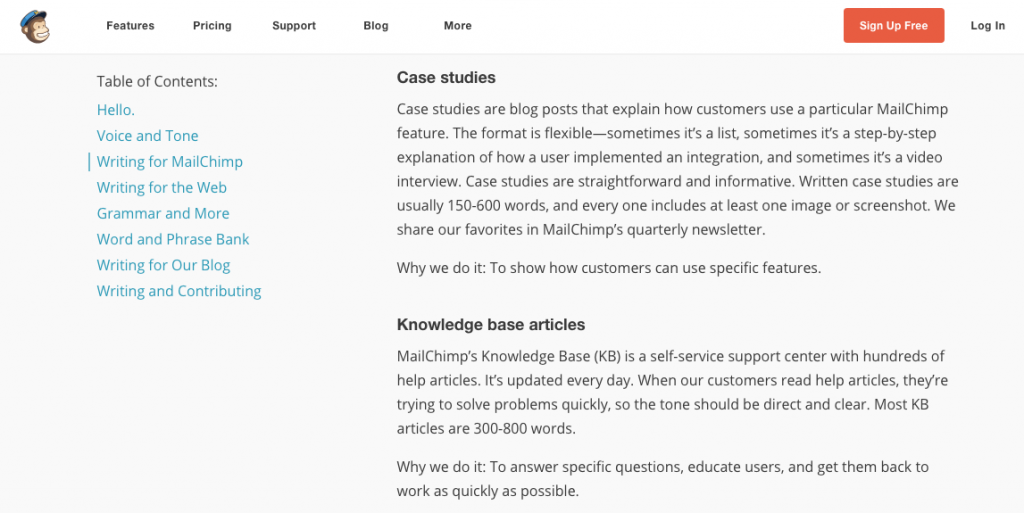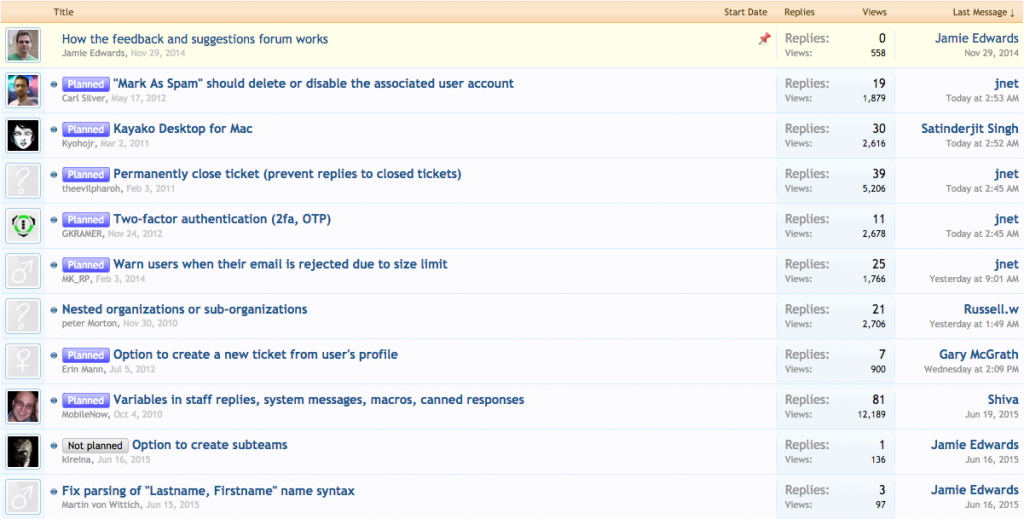Do you notice that you get many “bad” satisfaction tickets when customers are requesting product changes or new features?
Picture this scenario: A customer requests a feature. Support politely tells them that it can’t be done while still providing top quality service. However, the satisfaction survey comes back as bad, with a comment about the product, not the service.
Sound familiar?
Many of us have experienced similar situations before. The “bad” satisfaction tickets might be because we’re responding to feature requests in the wrong manner.
In some cases, we might already be building the feature. It might be easier to reply the customer in this scenario, and let them know the feature is on its way.
However, in most cases we won’t be planning on building those features, or at least not any time soon. Replying to these requests are more tricky as we have to tell the customer that they won’t get what they want while trying not to disappoint them.
Regardless of the situation, how we communicate with customers who give feedback is very important.
Are you ready to deliver Friction-Free Customer Service? Capture your customer’s entire journey in a way a support ticket or traditional help desk never could. Discover Kayako Single View
Why do they give feedback?
Before we dive into how to communicate with these customers, let’s take a look at why they would spend their valuable time offering us their feedback.
According to a whitepaper by TFM&A Insights, most customers give feedback because they want to express their opinion (64%). More specifically, they do so to let companies know where they were doing poorly (57%) or well (49%).
These customers feel that they are a part of the company and want to help it become better and succeed. A research by InMoment’s market insights team found that when asked why they give feedback, four in five consumers stated that they enjoy offering feedback and making a difference.
How fabulous!
There are many benefits to listening to customers’ feedback, particularly gaining customer insight and learning how to improve your product. The feedback from our own customer community forum has had a huge impact on how our product has developed. However, this has only happened through responding, engaging and acting upon the great feedback we’ve received from our customers.
Importance of communicating with these customers
By responding to customers’ feedback and feature requests, we show that we are listening to them and that we value them as our customers. This helps strengthen customer loyalty.
Customers don’t just want to be heard by companies. They want to know what difference they can make. The research by InMoment found that consumers “want brands to let them know how they plan to use their feedback, whether or not it was helpful, and what changes it inspired.”
Customers expected companies to respond to them. So how should we go about communicating with these customers?
Overarching principles for communicating with customers
First, let’s look at some overarching principles for responding to feedback. In fact, these principles can be applied to almost all conversations with customers and not only with those who give feature requests.
1. Be open and honest
Before we decide how to respond, it’s important that we have the right mindset. Instead of hiding the truth from your customers to look good, customers will appreciate transparency more.
2. Be grateful for their effort
Regardless of the feedback, it makes sense to thank the customer for the time they took to share their thoughts with you.
According to Dave Chapman of Buffer, “Our customer knows what will help them best, and a feature request helps us stay in tune with what people want, need and expect from Buffer.” Hence, gratitude is the first thing they express when they receive feature requests.
3. Be courteous, not scripted
The next principle is to pay attention to your tone and language when replying to the customers. This matters a lot because you don’t want customers to feel like their suggestions have triggered an automated reply and that their suggestions will be going into the void.
Buffer uses a tone guide for communicating with their customers. MailChimp has a style guide for writing content such as their blog posts and knowledge base articles:
4. Don’t make promises you can’t keep
Interestingly, Automattic does not use a formal tone or style guide. Andrew Spittle of Automattic shared that instead of using a formal tone or style guide, they emphasize individual judgement and follow a few basic principles:
Promise updates, not timelines:
According to Andrew, “It’s better to say that a feature is on the way and that a customer should ‘Stay tuned!’ rather than say something with a date attached like, ‘We plan to launch this next month.’”
Stating a date creates an expectation and failing to meet it might result in disappointment or dissatisfaction.
Promise investigation, not fixes:
Andrew recommends saying “Let me check with the team and get back to you with more information.” over “I’ve reported that bug to the team so we can get it fixed up.”
Promising to fix a bug or implement what seems like a basic feature risks frustrating the customer. The “bug” may not be a bug. Or, the seemingly basic feature might turn out to be not feasible to implement.
5. Show understanding
In Support Ops’ podcast on Working with Feature Request Emails, Jeff Vincent from Wistia mentioned that most importantly, customers want to be heard. They want us to understand what the problem is and why they are excited about this idea.
A contextualized reply shows that you have given a proper thought to the customer’s feedback.
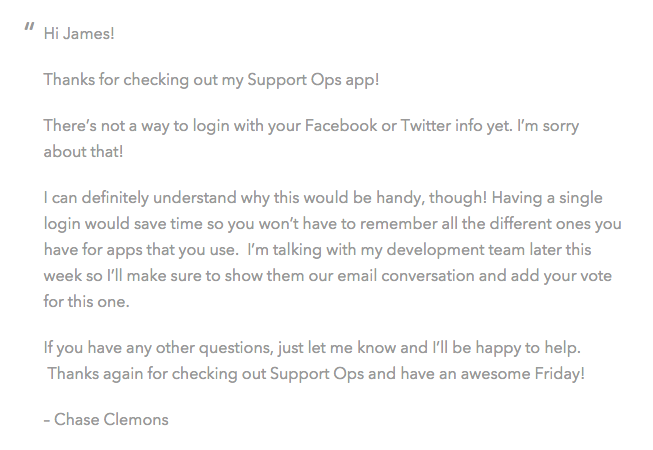
The hypothetical email above, suggested by Chase Clemons from Support Ops, does this well. By explaining why he thinks the suggested feature would be useful for users, he is showing that he considered the suggestion from the customer’s point-of-view.
Now, let’s dive in deeper into the two main situations: feature requests that you are not working on and those that you have already planned to do.
In The Ultimate Guide to Communicating Product Feedback, we show you how to make a case for your customer’s great feature requests. Download it now.
Feature requests that you are not working on
As much as we love our customers and their suggestions, we know that we do not have the resources to work on all the requests. Even when we could, it might not be the wisest thing to do.
“I know you have a thousand ideas for all the cool features iTunes *could* have. So do we. But we don’t want a thousand features. That would be ugly. Innovation is not about saying yes to everything. It’s about saying NO to all but the most crucial features.”
– Steve Jobs at a private presentation to independent record labels in 2003
However, nobody likes to be told “No”. Nobody likes to be rejected. So how do we say “No” and without angering them?
6. Find their real need
Before replying “No” immediately, pause for a moment and think from your customer’s perspective. Why do they want that feature?
Our co-founder Jamie wrote a great post about this where he explained how in the early years of Kayako we struggled with high volumes of customer feature requests. In many cases, we ended up directly implementing what the customer asked for, only to realize it wasn’t right for us, or even the customer!
In one instance, a substantial feature request was implemented only to turn out that the functionality the customer wanted could be achieved by making a minor change to an existing feature in the platform.
So we started using the 5 Whys principle to dig deeper into customer feedback. The 5 Whys means that by asking “why” five times, you’re able to tease out the real root cause of the problem and make the changes needed to resolve the underlying issue for good.
Soon, our team discovered that many feature requests were already in Kayako, but our customers just didn’t know where to look; some feature requests were bugs or problems we could troubleshoot; and less than 10% of feedback was actually a valuable and viable feature request.
Here’s an example of how we use the 5 Whys:
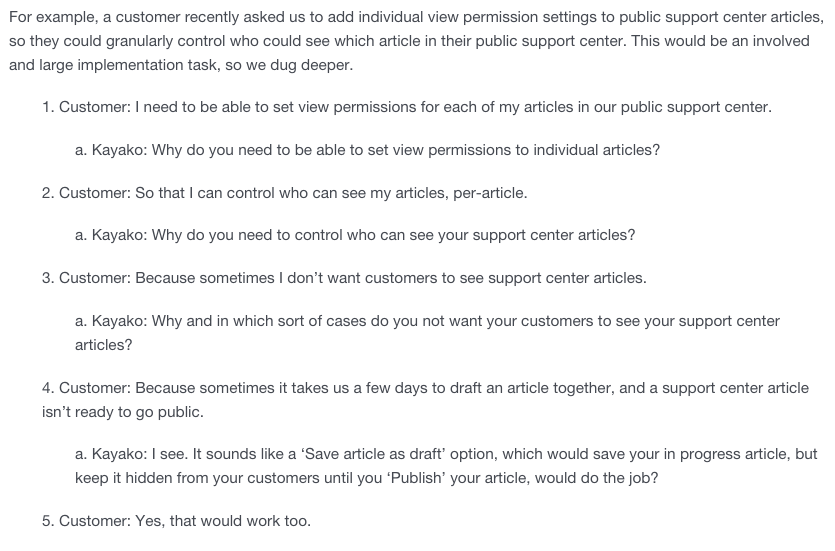
Adii Pienaar, co-founder of WooThemes and now Receiptful, also wrote a great post on this topic. He suggested that startups should try and understand the end goal customers have when they request for a feature.
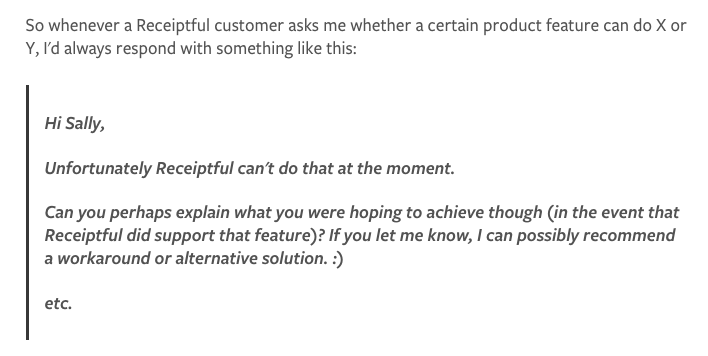
He said that this not only allows you to learn from the customers but also engages the customers, lets them know that you are listening and communicates that you care about their wants and needs.
7. Offer workarounds
As we talked about in politely rejecting customer requests, there’s some kind of “yes” most of the time.
Your customers may not know your product as well as you. So they might not know the possible workarounds. When you understand the real need that they have, you will be able to offer them alternative ways of using your product.
However, don’t create imaginative workarounds just to win a customer.
8. Give an honest explanation
Finally, if you really really have to say “No”, be transparent and provide an honest explanation for why you are not going to work on the feature. An honest explanation will help the customers understand your context and they might empathise with your situation.
Andrew of Automattic agrees, “If it’s not something we’re working on we tend to honestly thank the customer for the suggestion and, when applicable, be open about agreeing with them that it’s an area we need to improve.”
This might not be what the customer likes to hear, but putting in the effort to give a genuine explanation can help to build their trust in your company. It shows that you value them enough to explain how you will act on their feedback.
Feature requests that you have already planned for
What if you are already working on the feature? Easy work, right? Tell them that the features are coming soon and they will be satisfied! High five!
Not so fast!
Yes, they might be delighted that your team is already building the feature for them. However, they are still unable to use the feature now. The next question will pop up in their head – when can I use the feature?
9. Communicate ETAs honestly
Similar to dealing with feature requests that you are not working on, honesty is key.
At Buffer, they let customers know transparently where they are with the feature development – dreaming and discussing, customer research stage, building or testing. Through this, customers can form a rough expectation.
At Kayako, we found that it is not easy to communicate estimations for the date of completion of features and to manage customers’ expectations for them. Giving exact dates of completion can be an issue if we cannot deliver the feature on time. This can happen for a variety of reasons – a change in scope, focus or project timelines.
We taken this approach with our Product Feedback and Suggestions Forum: apart from a very small amount of exceptions, we do not provide ETAs for features. Where possible, we communicate the status of a particular feature suggestion using tags.
We use Planned, Not Planned and Completed tags to provide an indication without being too precise. Suggestions that are untagged mean that we have not decided on a course of action, typically because we want to hear feedback from other customers.
We have also written knowledge base articles to explain how the feedback system works and how we handle feature requests. All these help set appropriate expectations with our customers.
Certainly, this does not satisfy the expectations of all our customers who want more information and more features. We are still figuring out better ways to do this.
Similarly, at Campaign Monitor, if the requested feature is certainly on the roadmap, they might be more forthcoming about the fact that it’s coming in the future. However, they do not provide any sort of timeline as product development can be unpredictable.
If it’s on the brink of being released, Davida from Campaign Monitor said that she might even say something along the lines of “You’ll be happy to know that this feature will be in our next release, keep an eye on our blog for the announcement!”
As we can see, the common theme for communicating ETA seems to be like what Andrew from Automattic said, “promise updates, not timelines”. Product development can be unpredictable so we would not want to give promises that we might not uphold.
10. Provide updates on feature developments
When the feature is completed, it’s nice to go back to these customers to let them know that the feature they requested has been implemented. This makes sure they get a chance to use it.
For instance, Davida from Campaign Monitor said that if they add a feature that has been requested, they will get back to those customers even if it’s years later!
Even before that, perhaps you could get them to be beta users for the feature. At Buffer, if an unreleased feature is stable enough, the team would offer to enable it for the customer’s account for them to check it out.
When a customer requests the feature, the team can reply, “Do you know what, we’re working on that, fancy having a play? We’d love to know what you think!”
Are you ready to increase your team’s efficiency? Provide a better employee experience and speed up internal support with Kayako HelpDesk. Discover Kayako Self Service
It’s a two-way street
I like to think of this situation as a two-way street. When customers make the effort to offer a feature request or suggestion, it is only right for us to reciprocate by taking the time to understand their requests and respond to them honestly and politely.
By communicating with the appropriate mindset and language, we can give a response that the customers would, hopefully, be satisfied with and prevent bad satisfaction survey. Happy customers and happy agents – a win-win situation for us!
There isn’t a perfect way to reply to all feature requests as it depends a lot on the context. How do you normally handle feature requests and suggestions? We would love to hear about them! Share your expertise by leaving a comment below 🙂



